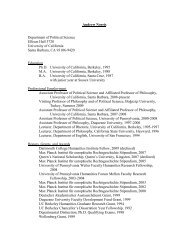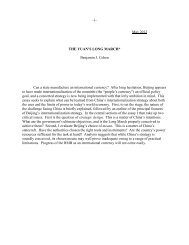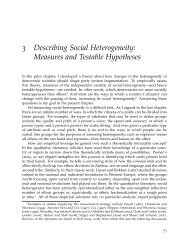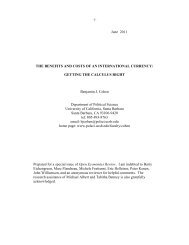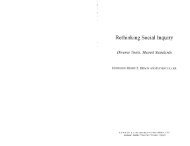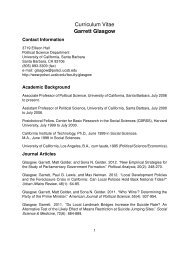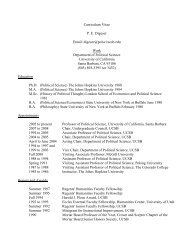Are Niche Parties Fundamentally Different from Mainstream Parties ...
Are Niche Parties Fundamentally Different from Mainstream Parties ...
Are Niche Parties Fundamentally Different from Mainstream Parties ...
Create successful ePaper yourself
Turn your PDF publications into a flip-book with our unique Google optimized e-Paper software.
ARE NICHE PARTIES DIFFERENT? 519<br />
TABLE 1<br />
Independent Variables<br />
Explaining <strong>Parties</strong>’ Policy Shifts<br />
Public opinion shift<br />
0.97 ∗∗<br />
(0.19)<br />
<strong>Niche</strong> party 0.02<br />
(0.12)<br />
Public opinion shift × <strong>Niche</strong><br />
−1.52 ∗∗<br />
party (0.33)<br />
Previous policy shift<br />
−0.50 ∗∗<br />
(0.09)<br />
Previous change in vote share 0.02<br />
(0.01)<br />
Previous policy shift × Previous −0.01<br />
change in vote share (0.02)<br />
Country Dummies †<br />
R 2 0.33<br />
N 158<br />
Note: ∗ indicates a coefficient that is significant at the p = 0.05<br />
level, ∗∗ indicates a coefficient that is significant at the p = 0.01<br />
level, both two-tailed tests. Standard errors are in parentheses.<br />
The dependent variable was the party’s ideological shift between<br />
election t − 1 and election t (the current election), based on the<br />
CMP codings of parties’ Left-Right positions. The definitions of<br />
the independent variables are given in the text.<br />
† The estimated parameters for the country-specific intercepts were<br />
(standard errors in parentheses): Britain 0.28 (0.25); Denmark<br />
−0.11 (0.21); France 0.09 (0.18); Greece −0.12 (0.24); Italy 0.17<br />
(0.26); Luxembourg 0.24 (0.23); The Netherlands 0.20 (0.20);<br />
Spain −0.12 (0.23).<br />
The coefficient on the public opinion shift variable is<br />
positive and statistically significant (p < 0.01), indicating<br />
that there is strong evidence that mainstream parties adjust<br />
their policies in response to shifts in public opinion.<br />
However, the estimated coefficient for the public opinion<br />
shift × niche party variable is negative and statistically<br />
significant (p < 0.01), indicating that there is a statistically<br />
significant difference in the extent to which niche<br />
and mainstream parties adjust their policies in response<br />
to shifts in public opinion, with niche parties’ policy programs<br />
less responsive to shifts in public opinion than are<br />
the policy programs of mainstream parties. This finding<br />
supports the Policy Stability Hypothesis.<br />
Note that the Policy Stability Hypothesis makes a prediction<br />
about the difference in responsiveness between<br />
niche and mainstream parties, which means simply testing<br />
the coefficient for the public opinion shift × niche party<br />
variable is sufficient to evaluate our hypothesis. However,<br />
the substantive effect of a public opinion shift on party<br />
policy programs is also of interest. To determine this we<br />
must calculate the coefficients and standard errors for<br />
public opinion shifts conditional on the dummy variable<br />
for niche parties. 9 The expected policy shift for a mainstream<br />
party in response to a one-unit shift in public opinion<br />
is simply given by the coefficient on the public opinion<br />
shift variable, which reveals that when public opinion in<br />
a country shifts by one policy unit along the 10-point<br />
Eurobarometer Left-Right scale, then, ceteris paribus, the<br />
mainstream parties in this country can be expected to<br />
shift approximately 0.97 units along the 10-point CMP<br />
Left-Right scale in the same direction as public opinion.<br />
For niche parties the expected policy shift in response to a<br />
one-unit shift in public opinion is −0.55, which is statistically<br />
significant (s.e. = 0.26, p = 0.04). Thus, not only<br />
are niche parties less responsive to public opinion than<br />
mainstream parties, but we can reject the proposition that<br />
niche parties adjust their policy positions towards public<br />
opinion at all.<br />
Among the control variables, the coefficient on previous<br />
policy shift is negative and statistically significant,<br />
revealing that parties tend to shift in the opposite direction<br />
to their previous policy shift, while the coefficients<br />
on previous change in vote share and the interaction between<br />
these control variables are not statistically significant,<br />
suggesting that previous election results do not influence<br />
party policy shifts. These results are consistent<br />
with the findings reported in Adams et al. (2004).<br />
Sensitivity Analyses<br />
We performed several tests in order to evaluate the crossnational<br />
comparability of our data and model and to consider<br />
alternative explanations for our findings. First, we<br />
address the possibility that the reliability of the CMP’s<br />
Left-Right coding procedures may vary across countries.<br />
Pelizzo (2003), for instance, argues that the CMP’s coding<br />
procedures do not accurately measure shifts in the Italian<br />
parties’ Left-Right positions (see also Kitschelt 1994). If<br />
the results in Table 1 are driven by measurement errors<br />
<strong>from</strong> a single country, omission of this country’s data <strong>from</strong><br />
our analysis should alter our substantive conclusions.<br />
Thus, we reestimated our model, omitting one country<br />
at a time <strong>from</strong> the pooled data. These estimates continue<br />
to support our substantive conclusions, and convince us<br />
9 Drawing on the notation <strong>from</strong> equation (1), these conditional<br />
coefficients are given by = B ∂V(t) 1 + B 3 ×NP J , while<br />
∂P (t)<br />
∂P (t)<br />
the conditional standard errors are given by s.e.(<br />
√ ) =<br />
∂V(t)<br />
var(B1 ) + NP 2 J<br />
× var(B 3 ) + 2NP J × cov(B 1 , B 3 ) (see Brambor,<br />
Clark, and Golder 2006). For mainstream parties (when NP J = 0)<br />
the coefficient and standard error are simply B 1 and s.e. (B 1 ) (the<br />
coefficient and standard error on public opinion shift), while for<br />
niche parties (when NP J = 1) the coefficient is (B 1 + B 3 ), and the<br />
conditional standard error is given by a straightforward calculation.




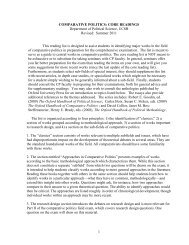
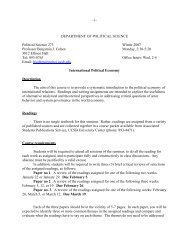

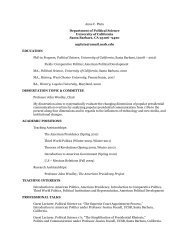
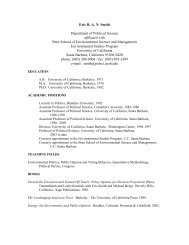
![Curriculum Vitae [abbreviated] John T. Woolley Professor of Political ...](https://img.yumpu.com/25423597/1/190x245/curriculum-vitae-abbreviated-john-t-woolley-professor-of-political-.jpg?quality=85)
